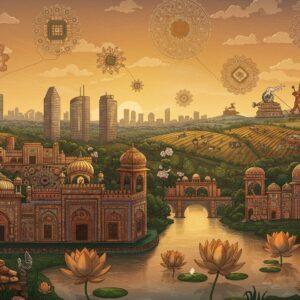
Embark on a captivating journey through the annals of Sikkim, a land once revered as the Kingdom of Sikkim. Nestled in the Himalayas, this enchanting region unveils a rich tapestry of history and culture. Discover how its unique geographical location shaped its political and cultural evolution, transforming from a sovereign kingdom to an integral part of India. This exploration is crafted for those who cherish deep cultural roots and appreciate the preservation of historical traditions, offering a glimpse into a world where the past gracefully intertwines with the present.
A Historical Overview: From Ancient Roots to Modern Times
The story of the Kingdom of Sikkim begins in 1642 with the ascension of Phuntsog Namgyal, the first Chogyal, a title signifying both temporal and spiritual leadership. He laid the foundation for the Namgyal dynasty, which guided Sikkim’s destiny until 1975. The kingdom’s cultural and political landscape was profoundly shaped by the tenets of Tibetan Buddhism, intertwining spiritual beliefs with everyday life. Sikkim’s strategic location, nestled between Tibet, Bhutan, and Nepal, played a pivotal role in the intricate dance of regional politics. The Lepchas, Bhutias, and Nepalese, among other ethnic groups, wove together the vibrant threads of its diverse social fabric.
The year 1861 marked a significant turning point with the Treaty of Tumlong, which established Sikkim as a British protectorate. During this era, agriculture and trade flourished as vital economic lifelines, while the hallowed halls of monasteries served as sanctuaries for Sikkim’s unique cultural heritage, preserving ancient wisdom and traditions for generations to come. For a deeper understanding of the history of Hinduism, you can explore this insightful article and this concise exploration of its origins.
Symbols of a Kingdom: The Flag and Anthem
The flag of the Kingdom of Sikkim, a powerful emblem of identity, bears the sacred Khorlo, the Buddhist wheel, symbolizing the profound connection to the Dharma. Each color and design element carries deep symbolic meaning, reflecting the kingdom’s values and spiritual foundations. The national anthem, known as “Aayo Sikkim,” resonated with the pride and heritage of the kingdom, drawing inspiration from the musical traditions of Tibet and Nepal.
These symbols served as beacons of Sikkim’s distinct identity amidst external influences, playing a central role in cultural events and ceremonies. Their legacy continues to resonate in contemporary Sikkim, a testament to their enduring significance.
A New Chapter: Sikkim’s Integration with India
The 20th century brought a period of political complexities and internal strife to Sikkim. External pressures, particularly from India and China, exerted influence on its affairs. Unrest in 1973 led to Indian intervention, culminating in a referendum in 1975 that resulted in Sikkim becoming the 22nd state of India. This historic decision marked a profound shift from monarchy to democracy, reshaping governance and the socio-cultural landscape. Diverse communities held varied perspectives on this integration, impacting Sikkim’s evolving identity and development.
A Living Legacy: Sikkim’s Enduring Culture
Sikkim’s cultural legacy continues to flourish, expressed through vibrant festivals such as Losar, Bumchu, and Saga Dawa, which showcase its rich Buddhist heritage. Monasteries stand as guardians of ancient manuscripts, religious art, and traditional music, preserving the wisdom of generations. The Sikkimese diaspora plays a vital role in maintaining cultural ties across the globe. The forces of modernization and tourism influence cultural preservation efforts, prompting local and governmental initiatives to document and promote Sikkim’s unique identity. Balancing cultural preservation with economic development remains paramount for contemporary Sikkim.
What led to the decline of the Kingdom of Sikkim? A confluence of factors contributed to this transition, including political instability, economic challenges, and the growing desire for democratic governance, ultimately leading to the merger with India.
What is the significance of Sikkim’s lost kingdom today? The legacy of the kingdom continues to resonate deeply within Sikkim’s cultural fabric. Its rich history and Buddhist traditions remain influential, celebrated through vibrant festivals, sacred monasteries, and the preservation of traditional practices. The integration with India marked a new chapter, blending the kingdom’s heritage with the dynamism of a modern nation. You can delve deeper into understanding the historical journey of Hinduism here.
Poojn.in: Honouring Sikkim’s Sacred Traditions
At Poojn.in, we understand the deep significance of Sikkim’s spiritual heritage. As India’s leading provider of puja samagri and religious essentials, we offer a curated selection that resonates with the region’s rich Buddhist and Hindu traditions. We are proud to be India’s largest Dashakarma bhandar, providing authentic ritual items used in traditional Sikkimese ceremonies.
- Pure Copper Butter Lamps: Illuminate your sacred space with the warm glow of pure copper butter lamps, traditionally used in Buddhist monasteries. These lamps are crafted with meticulous care, embodying the reverence of ancient practices. Explore our collection here.
- Premium Incense from the Himalayas: Enhance your spiritual practice with the fragrant aromas of premium incense sourced from the Himalayas. Each stick is imbued with the essence of sacred herbs and resins, creating an atmosphere of serenity and devotion. Discover our range of incense.
- Brass Bells and Singing Bowls: Immerse yourself in the resonant tones of brass bells and singing bowls, traditionally used in meditation and prayer. Their harmonious vibrations create a sense of peace and tranquility, deepening your spiritual connection. Find your perfect bell or singing bowl here.
We recognize the importance of using genuine materials for religious practices. Every product on Poojn.in is accompanied by detailed information about its significance and proper usage, ensuring authenticity and reverence. For bulk orders for monasteries or temples, please reach out to us at 03369029784 or connect with us on WhatsApp at 9476142738 for personalized assistance and special pricing. Experience the convenience of online shopping while upholding the sanctity of your traditions. We offer secure packaging and delivery across India to protect your sacred items.
Sikkim: A Timeless Tapestry of Heritage
Sikkim’s transformation from a sovereign kingdom to a vibrant state within India is a testament to its resilience and adaptability. Its rich history and cultural legacy continue to inspire, reflecting the enduring spirit of its people. From colorful festivals to sacred monasteries and diverse communities, Sikkim celebrates a harmonious blend of traditions, ensuring its heritage remains vibrantly alive. As you explore the wonders of modern-day Sikkim, you connect with centuries of history, stories of kings, and the melodies of its anthems. Let this journey inspire a deep respect for the cultural tapestries that enrich our world. Sikkim, with its timeless charm, welcomes you to become a part of its ongoing narrative.


